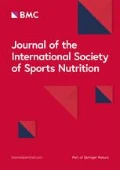Background
A randomized, double-blind, placebo-controlled study was performed to evaluate the effects of oral BCAA and leucine supplementation combined with an acute bout of lower extremity resistance exercise (RE) on the phosphorylation/activation states of mTOR and 4EBP1.
Methods
30 fasted, recreationally trained males (22.5 yrs; 83.1 kg; 178.4 cm) consumed 120 mg/kg/bw of BCAA, 60 mg/kg/bw of leucine, or a placebo. The supplements were consumed in three equal doses at 30 minutes before RE, immediately prior to RE, and immediately post RE. The participants completed 4 sets of both leg press and knee extension at 80% of their 1 RM to failure (~8–12 reps). Rest periods of 2.5 minutes were given between both sets and exercises. Percutaneous muscle biopsies of the vastus lateralis were obtained at: baseline, and 30 minutes, 2 hours, and 6 hours post RE. The phosphorylated states of both mTOR and 4E-BP1 were assessed through the use of an ELISA with a primary antibody specific to phosphorylated mTOR [pS2448] and a phosphoELISA kit for phosphorylated 4E-BP1 [pT46], respectively. Other serum and muscle variables were analyzed as part of a greater, overall study, but only the phosphorylated mTOR and 4E-BP1 are reported in this abstract. Delta values of mTOR and 4E-BP1 were analyzed using a 3 (group) × 4 (time) repeated measures MANOVA. Separate ANOVAs for each criterion variable were utilized as follow-up tests. Significant main effects were determined Bonferroni post-hoc tests. Significant interactions discovered in the ANOVAs were assessed by independent samples T-tests. SPSS version 15.0 was utilized throughout this analysis.
Results
There was no main effect for group, time or group × time interaction for phosphorylated mTOR. In regards to phosphorylated 4E-BP1, no main effect for time was observed. However, a significant group main effect for 4E-BP1 was observed (p = 0.002). Bonferroni post-hoc analysis demonstrated that both the BCAA group (p = 0.002) and the leucine group (p = .037) were significantly greater than the placebo group in regards to phosphorylated 4E-BP1. Additionally, a group × time interaction for 4E-BP1 was also observed. Activated 4E-BP1 was significantly greater in the BCAA group (p = 0.001) and leucine group (p = .037) at 2 hours post RE as compared to the placebo. At 6 hours post RE, 4E-BP1 activation was greater in the BCAA group as compared to both the placebo (p = 0.022) and leucine groups (p = 0.041).
Conclusion
Both leucine and BCAA supplementation, combined with an acute bout of lower extremity RE, led to greater levels of phosphorylated 4E-BP1, as compared to a placebo, 2 hours following RE. Furthermore, BCAA group led to significantly greater levels of activated 4E-BP1 when compared to both the placebo and leucine at 6 hours post RE. These findings suggest that the other two BCAAs (isoleucine and valine) may contribute to greater activation states of 4E-BP1 above and beyond that of leucine alone. Lastly, in the current study, neither BCAA nor leucine supplementation did not have a significant effect on the phosphorylation state of the cell signaling protein, mTOR.
Author information
Authors and Affiliations
Corresponding author
Rights and permissions
Open Access This article is published under license to BioMed Central Ltd. This is an Open Access article is distributed under the terms of the Creative Commons Attribution 2.0 International License (https://creativecommons.org/licenses/by/2.0), which permits unrestricted use, distribution, and reproduction in any medium, provided the original work is properly cited.
About this article
Cite this article
La Bounty, P., Campbell, B., Oetken, A. et al. The effects of oral BCAAs and leucine supplementation combined with an acute lower-body resistance exercise on mTOR and 4E-BP1 activation in humans: preliminary findings. J Int Soc Sports Nutr 5 (Suppl 1), P21 (2008). https://doi.org/10.1186/1550-2783-5-S1-P21
Published:
DOI: https://doi.org/10.1186/1550-2783-5-S1-P21

